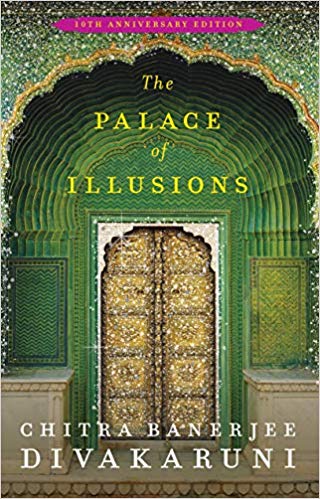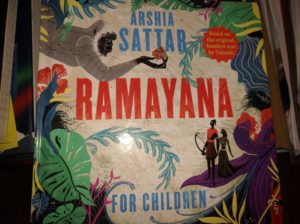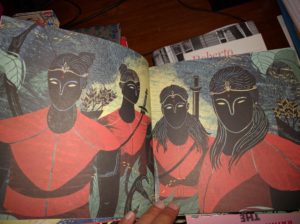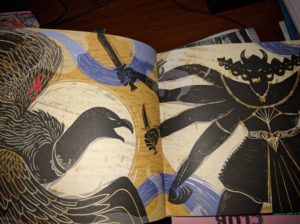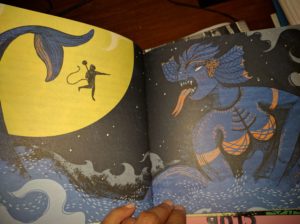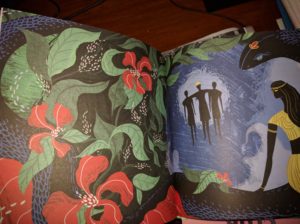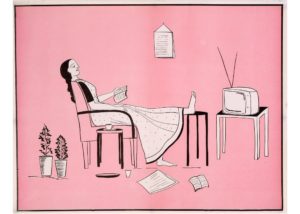An interview with Chitra Banerjee Divakurni about “The Forest of Enchantment”
Chitra Banerjee Divakurni and I first met some years ago when I had to interview her at CMYK bookstore, Mehrchand market, New Delhi. Ever since then we have remained in touch and I have enjoyed reading and interviewing Chitra’s books published over the years. This time too I read The Forest of Enchantment and discovered that the book was unexpected. Given below is an extract from our email correspondence as a background to the interview that follows.
Dear Chitra,
It has been such a pleasure to read your latest novel, The Forest of Enchantment. It was unexpected too. Over the years you have raised readers expectations to create strong women. Women who learn to make choices while in the prime of life or later while reflecting upon their lives as they age. The reader is privy to the heroine’s inner thoughts and formulates for his/herself an image of a strong woman. In the long run perhaps these heroines offer a role model of behaviour to many of your readers. I do not know for certain but I am sure it does have an impact when a hugely successful author like yourself is read worldwide. This was obvious in what you did in Palace of Illusions too. As the author you had inserted yourself many times in the narrative (at least that is how I recall it) but allowed the heroine her ground too. To my mind that was the turning point in your writing. Surely and steadily your heroines through a combination of action and inner thought processes began to evolve and offer a new generation of readers a fresh new way of approaching life. More so when modern life is not so stable anymore and inevitably cuts across cultures and continents. Physical movements happen (a truth many women learn to accept as part of their life’s journey), so the experience of migration while traumatic itself is an experience that the woman has been “trained” from girlhood to foresee and brave. It will happen. It has to happen. At least for millions of those women who are taught in childhood that marriage is a social milestone they must cross. But it is the marital life that you excel in detailing, Chitra.
Then you create The Forest of Enchantment. In the first few pages I felt it was a writer’s treatise on how to approach a retelling of a well-established story. It is oh! so tricky “converting” an oral tradition into the written and fixed narrative on the printed page. Your opening pages are like the opening invocation to the powers-that-be before embarking on a spiritual journey or like a prayer seeking blessings before telling the story as you wish to. It is a story to make your own. It left me with a mixed bag of feelings. Your retelling of Sita’s story comes precisely a decade after your super bestseller about Draupadi, The Palace of Illusions. I was expecting a Sita more along the lines of Draupadi. Gently strong — a quality that one does tend to associate with the two women. And then you create a woman who at first glance comes across as compliant, ever humble and always giving of herself. Exemplary qualities for any individual to possess, irrespective of gender, but these are what Sita is classically associated with. You imbue your character Sita with them as well. The story crafted reiterates this at every step of the way. To read this novel immediately after the #MeToo movement as a reader in the modern age has a disquieting impact. Then I decided to read it from your perspective of writing it. I have no idea if that last sentence makes sense. I decided to drop all my expectations of this book based on your previous heroines and read trying to align myself with your meditative discipline of writing and focused attention to detail, hoping I will learn something new. Perhaps I did. Perhaps I did not. But what I did discover was that it is best to pay heed to Sita, feel to some degree what she experiences, and it is like coming to terms with the battering women get through life. They learn to make their choices but also compromise a lot in the long run for the peace of those around them especially their husbands. It is a conservative approach that many enlightened women may not agree with but at some levels I suspect I understand why you chose this option. Was it a conscious choice to capitulate to an acceptable version of Sita rather than challenge it any way as say Volga has done with her retellings? As I said in my opening remarks that The Forest of Enchantment was unexpected. Nevertheless, it did give my much to dwell upon for which I have to be ever grateful to you.
****
Chitra Banerjee Divakurni’s reply:
Thank you dear Jaya for reading so carefully and for your very thoughtful comments and questions. I have lots of answers. And also for your support of my work and your friendship from ever since we first met.
Fondly, Chitra
****
1. Why did it take you so long to write about Sita considering you wrote about Draupadi a decade ago?
Sita is a very different character. Where D is flamboyant and direct and headlong in the way she fights injustice, and not above doing wrong things herself when overcome by anger and the desire for revenge, Sita is an old soul and much more complex in her approach to problems. I had to grow myself to understand her particular kind of strength, because I had grown up resisting her as an icon. But hers is the strength of endurance, of never giving up or giving in, no matter how few external choices are available. It is the strength that flourishes and makes space for itself even in the most hostile of environments–much like a tree that grows amidst rocks and stones. It does not stray from its principles. Together, D and S provide Indian women with two complementary ways of being strong and self-respecting in the world. Sita’s way may not seem as exciting at first, but upon reflection one realizes, I hope, that it is the way more suited to, and more doable, for most women–in India and in the world. Because often we, too, are struggling to thrive in unhospitable circumstances. And we, too, would like to be good human beings in the process.
Sita isn’t defiant by nature, but when faced with dire situations she is perhaps stronger than Draupadi is. For centuries, patriarchy has chosen to interpret her quietness as meekness. I hope I’ve managed to show in my novel that it isn’t so. What is it but her inner strength, and her conviction, that prevents Ravan from harming her once she is in his power? What but her inner strength allows her to stand up to Ram and say that he cannot dictate how she will lead her life, even if he rejects her? She is the one who calls for the fire into which she walks at the end of the battle in Lanka. She is the one who pulls herself together when abandoned in the forest, to promise herself and her unborn sons that she will bring them up as the best of princes–and the best of men, who will know how women should be treated. She is the one who refuses to compromise and speaks her mind in the court of Ayodhya before she chooses to leave this mortal earth and the happiness of queenship, family, husband and children. She does it because she has deeply-held values and stands up for them. And she does it without anger or vengefulness because she has come to realize that these are destructive–and ultimately useless–emotions. I don’t think Draupadi could have done it.
It took me ten years of contemplation to realize all this.
2. Why is the Bengali Krittibasi Ramayan from the fifteenth century your favourite? What are the elements in it that stand out for you as exceptional?
The Krittibasi Ramayan is much more interested in Sita’s inner life and gives us more of her thoughts than Valmiki. It portrays little intimate moments in her life. It portrays Ravan as a more nuanced character. It also doesn’t shy away from depicting disquieting scenes like the mutilation of Surpanakha in a way that makes us question the act. I was attracted to all these things.
3. Did your crafting of your women protagonists drain or enrich you as the case maybe in understanding the character of Sita better?
The immediate writing is draining because it is so consuming. But ultimately, understanding my characters always enriches me. Certainly this is true of Sita’s character.
4. Sita is beloved to many. Hindus consider her to be the epitome of an ideal woman. As a result did the creation of her character for The Forests of Enchantment become a tough negotiating act for you? How do you retell a story that has been told for centuries and yet make it so much your own?
Yes, exactly these reasons made this a challenging book to write. As I read and re-read the Ramayana, I felt that we haven’t understood Sita properly. We’ve interpreted her actions in the way that patriarchy finds most useful. I tried to make the story my own by examining–and feeling–Sita’s motives. One simple instance: when she “follows” Ram to the forest, she is generally judged to be a “pativrata” who follows her husband wherever he might go. But really, when you look at the scene in both Valmiki and Krittibas, she is going against what all her elders are asking/telling her to do. Ram, Kaushalya–everyone–says, please stay in the palace. She says, “No. I want to be by the side of my beloved. I want to live the same life, experience the same adventures. I love him and refuse to be parted from him.” It is an action of great agency and rather romantic. So, ultimately, Sita is also very human. Another example: The things she says to Lakshman when she thinks Ram is in danger when he goes after the golden deer! The way she accuses him of desiring her!
5. When do you stop reading past narratives and create your own?
When I feel they have missed something important. But in the case of our epics, it is important for me to stay with the original story line. Otherwise readers might (rightly) say, “You are just making up this story. It has nothing to do with the ‘real’ Sita.” It is also more challenging to transform the reader’s understanding of a character without changing much of anything external about her life and, instead, illuminating her thoughts and motives. This is why, although I really enjoy and admire writers such as Volga, I don’t want to write that kind of story.
6. On p.2 of the novel Valmiki says “I wrote what the divine showed me.” Is this a sentiment that you share too with regard to your writings?
I truly believe I couldn’t write even one word without divine help. Like a flute that makes music only when the master musician blows into it. But sometimes the holes are blocked (ego? ignorance? lack of effort?) and the music doesn’t come out sounding so good. Then I have to rewrite!
7. Will you record your own audio book of this story? If not who would you like to have as the voice actor?
No, I have no interest in doing that. Better to have a professional. I’d love to know who readers think would be a good narrator.
8. Over the years has your writing style changed as you tackled the crafting the inner self of your women characters?
Yes, it changes with each book. It has something to do with the subject matter and the narrator. I can’t really explain it. I spend a lot of time in the first chapter trying to find the book’s “voice.”
9. How have your readers responded to the two books published exactly a decade apart but both dealing with the Mahabharata and Ramayana epics? Any noticeable shifts in readers responses to The Palace of Illusions and The Forest of Enchantment?
Some readers like Draupadi better, some like Sita more. Many write to me that they have re-read Palace numerous times. But more (hundreds!) of women have written to me saying the story of Sita in Forest has made them weep and changed something deep in themselves. I am grateful for that.
10. Your fiction is known to explore the different aspects of love. Do you have a testament of love?
Forest is particularly focused on trying to make sense of the amazing and complicated emotion of love. I think my current understanding of love is what Sita realizes at the end of the novel: love and forgiveness have to go hand in hand. (This doesn’t mean that you will accept wrongdoing, only that you forgive the wrongdoer. In any case, I believe more and more than vengeance is a hugely harmful emotion). And that the best, truest love is between mothers and young children–because they want nothing except to make each other happy.
10 July 2019

